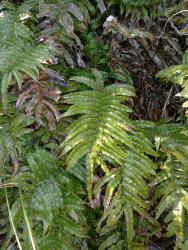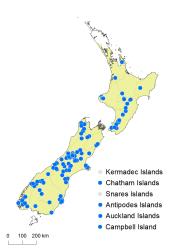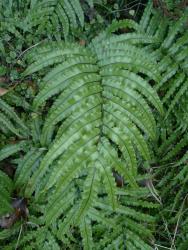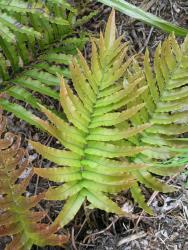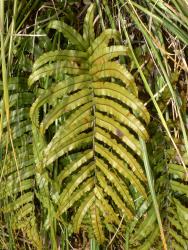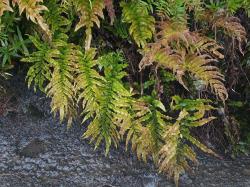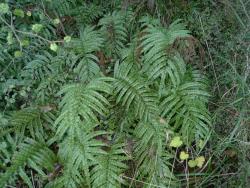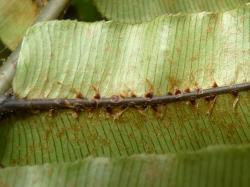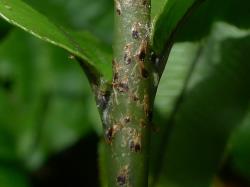- ≡ Parablechnum montanum (T.C.Chambers & P.A.Farrant) Gasper & Salino in Gasper et al., Phytotaxa 275: 216 (2016)
- = Lomaria procera var. tegmentosa Hombr. in Hombron & Jacquinot, Voy. Pôle Sud, Bot. t. 2e (1843)
Rhizomes short-creeping, up to 200 mm long (in herbarium material), bearing scales. Rhizome scales narrowly ovate, 8–14 mm long, 1.5–2.6 mm wide, chestnut-brown, concolorous or occasionally slightly bicolorous with paler margins. Fronds strongly dimorphic; sterile and fertile fronds of similar habit, arching outwards or hanging downwards; sterile fronds 200–1150 mm long; fertile fronds on same plant about equalling or a little shorter than the sterile fronds, 185–970 mm long. Sterile fronds. Stipes 60–620 mm long, sometimes black-brown at extreme base but mostly yellow-brown, bearing chestnut-brown concolorous scales and/or bicolorous scales with a conspicuous dark spot around the point of attachment. Rachises yellow-brown, grooved adaxially, scaly. Laminae 130–730 mm long, 60–280 mm wide, 1-pinnate, elliptic to ovate, with an undivided apical segment, bronze green, similar colour on both surfaces, red-tinged when young, coriaceous; scales on abaxial pinna costae with a dark spot around the point of attachment. Pinnae in 5–27 pairs, closely spaced, narrowly oblong, falcate, not reduced at the lamina base, or the proximal pair slightly reduced; the longest pinnae at or below the middle, 40–170 mm long, 7–24 mm wide, apices acute to acuminate, margins shallowly crenate, bases truncate or rounded, short-stalked; the basal pinnae opposite. Veins free. Fertile fronds. Stipes 90–680 mm long. Laminae 100–410 mm long, 30–200 mm wide. Pinnae in 7–25 pairs, linear, straight or falcate, 30–130 mm long, or rarely to 150 mm long, 2–6 mm wide, not reduced at the lamina base. Sori and indusia in one row either side of costa, continuous along the length of the pinna.
Blechnum montanum is recognised by its dimorphic fronds, free veins, pinnate sterile laminae, and continuous sori. The sterile laminae are elliptic to ovate, divided into falcate pinnae with acute to acuminate apices and short-stalked bases. The basal pinnae are opposite, and only the basal pair are sometimes reduced in size, and then only slightly. The laminae bear a mixture of chestnut-brown concolorous scales and bicolorous scales with a conspicuous dark spot around the point of attachment. Both surfaces are of similar colour, and the fertile fronds are equal to, or a little shorter than, the sterile fronds. Plants from the subantarctic have slightly wider pinnae on the sterile fronds.
Blechnum montanum is similar to four other closely related species with stalked, sterile pinnae. It is distinguished by its basal pinnae, which are scarcely reduced in size and rarely less than half the length of those at mid-lamina, unlike those in B. minus and B. novae-zelandiae, which are many times shorter at the base than at mid-lamina. The pinnae are falcate, taper to acute or acuminate apices, and are arranged in 5–27 pairs, unlike those in B. procerum, which are straight, have obtuse or rounded apices, and are arranged in 1–12 pairs. B. montanum is most similar to B. triangularifolium but distinguished by its narrower, sterile laminae (60–280 mm wide, cf. 90–560 mm wide), smaller number of sterile pinna pairs (5–27, cf. 6–32), and bronze or olive-green rather than pale green fronds. B. montanum is a montane or subalpine species found more frequently in the South Island, whereas B. triangularifolium is a lowland species.
North Island: Auckland, Volcanic Plateau, Gisborne, Taranaki, Southern North Island.
South Island: Western Nelson, Sounds-Nelson, Marlborough, Westland, Canterbury, Otago, Southland, Fiordland.
Chatham Islands, Antipodes Islands, Auckland Islands, Campbell Island.
Altitudinal range: 10–1375 m.
Blechnum montanum occurs in montane to subalpine areas of the North Island from the Coromandel Peninsula to the southern Tararua Ranges. The hybrid, B. montanum x B. novae-zelandiae, has been recorded from Tangihua Forest, Northland (AK 174551, AK 204579; Chambers & Farrant 1998), but no collection of B. montanum has yet been made. Chambers also identified plants from the Waitākere Ranges as hybrids (e.g. AK 166733-166737), but no unequivocal collection of B. montanum has been made. It grows from 450 m near Wellington to 1375 m on Mt Taranaki. In the South Island it occurs in montane to subalpine areas throughout, growing from 60 m at Tahakopa Bay, Southland, to over 1300 m in north-west Nelson. It has not been recorded from Stewart Island, but is found on the Chatham Islands, and on the Auckland, Campbell and Antipodes Islands, where it descends almost to sea level.
Blechnum montanum is a terrestrial fern found in podocarp, broadleaved and beech forest, under mānuka and kānuka, in pine forest, in subalpine scrub and herbfield, and in tussock grassland. It grows in rocky gorges, on cliffs, amongst rocks, on rock outcrops, on roadbanks and cuttings, on stream banks, near waterfalls, amongst tussock, and in fernland and peat bog. In the subantarctic it grows under Metrosideros forest, Dracophyllum scrub and among megaherbs.
Blechnum montanum is thought to hybridise with B. novae-zelandiae (e.g. AK 203698, Lake Rotoiti; CHR 323665, Waipawa R., Ruahine Ranges), the distributions of the two species often overlapping in montane habitats (Chambers & Farrant 1998). Hybrids between B. montanum and B. procerum (e.g. AK 174551, Tangihua Forest, Northland; AK 44043, Mt Troup, Doubtful Sound; CHR 260060, Otokoro Stream, Kaimanawa Range) have also been reported by Chambers & Farrant (1998).
2n = 56 (Chambers 1954; Chambers & Farrant 1998).



